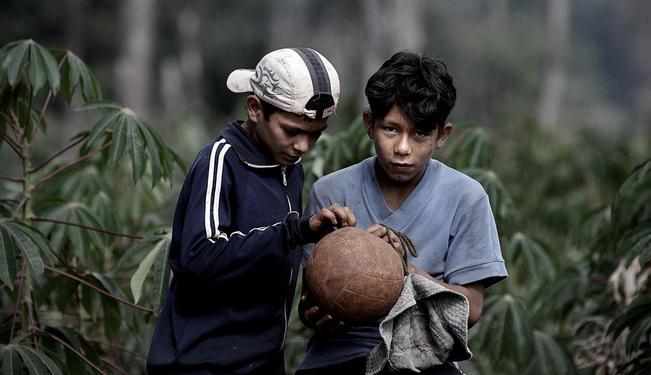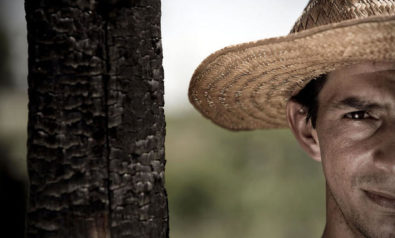The small farming community of Tekojoja has been on the front line of this struggle for years. Its history and struggle is representative of countless other farming communities in the Paraguayan countryside.
Paraguayan campesino removes soy
The community of Tekojoja is home of the Popular Agrarian Movement (MAP) of Paraguay. It is a place that has faced enormous repression from the soy farmers and their thugs, and led a legendary resistance against them, producing many campesino leaders.
Tekojoja stands on land given to campesinos as part of a Public Land Reform Program. In the 1990s, Brazilian soy farmers—with armed thugs, lawyers, and political connections to protect them—gradually expanded onto the community’s land, forcing a series of violent evictions of the farming families. In 2003, the MAP began to recover the lands taken from them by Brazilians, but corrupt judges and the mercenaries hired by soy producers kept pushing the farmers off their land.
On December 2, 2004, Brazilian land owners accompanied by police burned down numerous houses and farmland in Tekojoja as part of an eviction process. A statement from the MAP described this brutal act:
[A]fter the tractors destroyed our crops, they came with their big machines and started immediately to sow soy while smoke was still rising from the ashes of our houses. The next day we came back with oxen and replanted all the fields over the prepared land. When the police came, we faced them with our tools and machetes. There were around seventy of us and we were ready to confront them. In the end they left.
The campesinos’ houses and crops were destroyed and they had no assurances that the Brazilians would not orchestrate another eviction. Still, as most had no place to go, the community members decided to persevere, staying on the land and fighting for legal recognition as the owners. Roa explained, “We planted seeds with fear as we didn’t know if our crops would be destroyed. And we began to reconstruct the houses.” But again at 4 a.m. on June 24, 2005, the Brazilians and police attacked the community. “They arrested children, blind people, old men, and pregnant women, everyone, throwing them all in a truck.” Roa said. “They threw gas and oil on the houses, burning them all down as the arrests went on.”
In this standoff between the thugs, police, and unarmed campesinos, two farmers, who the Brazilians mistakenly identified as MAP leaders and brothers Jorge and Antonio Galeano, were killed by gunfire. One of the victims was Angel Cristaldo Rotela, a 23 year old who was about to be married, and had just finished building his own home the day before the police burned it to the ground. The wife of Leoncio Torres, the other victim, was left a widow with eight children. A memorial stands in the center of the community in memory of the fallen campesinos.
After the murders, campesinos and activists from around the country rallied in support of Tekojoja, supplying the besieged community members with tarps and food. Finally, the Supreme Court ruled that the land should go to the local farmers, and as part of the reparations for the violence the community suffered, President Nicanor Frutos commissioned the building of forty-eight homes. The plight of Tekojoja sheds light on the situation many farming communities are finding themselves in across Paraguay. While the residents of Tekojoja remain on their land, many others are forced to flee to slums in the city as soy producers push them off their land.
Roa explained this cycle of displacement:
When the small farmers are desperate, and the pesticides are hurting them, there is no money, and so they sell their land for a little money, which is more than they’ve ever had, thinking that life in the city will be better, easy—but it’s not so easy. A lot of people who end up gathering garbage in the city are from the countryside. They don’t know how to manage their money, so for example, they’ll spend all their money on a used, broken-down car first, and then end up in the city broke, without any jobs or place to stay.
The victory of Tekojoja was due to the tenacity of the farmers who refused to leave their land for the false promise of rich city life. But their fight is far from over. Though they tore the soy plants out of their land, residents live sandwiched between seemingly limitless expanses of soy, and they, their animals, and their crops continue to suffer from exposure to toxic pesticides.
By dawn the next day, most of Roa’s neighbors were already up, getting to work before the sun made labor unbearable. Chickens milled about houses, the red dirt yards were still damp from the night’s dew, and radios tuned in to a community radio station mixing music with political commentary in Guaraní. A neighboring community activist invited us to his house to start the day with Paraguayans’ essential beverage, yerba maté served hot in the morning and specially prepared with coconut and rosemary. We sat in his kitchen as the sun streamed through the cracks between the boards in the wall, illuminating ribbons of smoke from the fire, while his children and pigs played on the dirt floor.
An ominous presence loomed over this bucolic scene. The neighboring Brazilian soy farmers had already shown up with their tractors, spraying pesticides on nearby crops. I could smell the chemicals in the air already. We walked toward the fields until the sweet, toxic odor grew stronger. We passed one tractor very closely as clouds of the pesticides drifted toward us. I began to feel a disorienting sensation of dizziness and nausea. My eyes, throat and lungs burned and my head ached, something the locals go through on a daily basis. The physical illness caused by the pesticides contributes to breaking down the campesino resistance.
I am reminded that this is a besieged community, not just because of the soy crops that circle these islands of humanity, or the pesticides that seep into every water source, crop, and conversation, but also because the Brazilian soy farmers live next to and drive through these impoverished communities with total impunity, and with the windows of their shiny new trucks rolled up tightly. Mounted somewhat precariously on the back of a few mopeds, we bounced along the dirt roads, which petered out into paths to another cluster of homes. On our way there, we passed one Brazilian who glared at us until we were out of sight. Roa knew him: he had participated in the razing and burning of their homes. The fact that he was still free added insult to injury. And if the locals were to accuse him, said Roa, or even yell at the Brazilian murderers, police would show up and haul them off to jail. “This is the hardest part,” she explained. “That we see them and can’t do anything.”
The moped rolled to a stop in front of Virginia Barrientos’ home, a few miles from Roa’s, directly bordering a soy field. The land Barrientos lived on for the past four years is a peninsula jutting into the sea of soy. She occupied her land, which used to be covered with soy, in February of 2005 and won legal ownership to it. But life since gaining the land has been far from easy; pesticides have terrorized her family since they moved there.
“Just before we harvest our food the Brazilians will spray very powerful pesticides,” Barrientos explained. “This spraying causes the headaches, nausea, diarrhea we all suffer.” Her thin children were gathered with her on the porch of the home. “There are a lot of problems with the water,” she continued. “When it rains, the pesticides affect our only water source.”
Barrientos said the pesticides affected her plants and animals as well, making some of the crops that do actually grow taste too bitter to eat. Her pigs’ newborn babies died, and the chickens were ill. Part of the problem, she pointed out, is that the Brazilian soy farmers intentionally choose to fumigate during strong winds which blow the poison onto her land. We passed dead corn stalks on the way to her well, which she insisted on showing us. It was located at the end of a long field of soy, so that the runoff from the field dripped into the well, concentrating the pesticides in her only water source. The family lives in a poisoned misery, while the soy producer responsible for it lives in comparative luxury away from his fields.
Isabel Rivas, a neighbor of Barrientos’ with a big smile and loud laugh in spite of her grim living situation, told us, “When we drink the water we can smell the chemicals. It turns out they were washing the chemical sprayers in our source of water, in a little stream nearby.” Barrientos stood in front of her house while breastfeeding her baby as chickens pecked at peanuts in the yard. Her children stared at us with wide eyes. “We can’t go anywhere else.”
While Lugo’s inability and unwillingness to sufficiently address such hardships was a betrayal of this grassroots sector, the recent coup against Lugo was also a coup against hope, a coup against Barrientos and her children, Roas and her neighbors, and the hundreds of thousands of farmers struggling in the countryside. Behind this coup lies the vast land, some of it poisoned, some still fertile, and much of it tear and blood-soaked. Until the demand of land justice is realized, there will be no peace in Paraguay, regardless of who sleeps in the presidential palace.
The views expressed in this article are the author’s own and do not necessarily reflect Fair Observer’s editorial policy.
*[This article was originially published by Upside Down World on July 16, 2012].
Support Fair Observer
We rely on your support for our independence, diversity and quality.
For more than 10 years, Fair Observer has been free, fair and independent. No billionaire owns us, no advertisers control us. We are a reader-supported nonprofit. Unlike many other publications, we keep our content free for readers regardless of where they live or whether they can afford to pay. We have no paywalls and no ads.
In the post-truth era of fake news, echo chambers and filter bubbles, we publish a plurality of perspectives from around the world. Anyone can publish with us, but everyone goes through a rigorous editorial process. So, you get fact-checked, well-reasoned content instead of noise.
We publish 2,500+ voices from 90+ countries. We also conduct education and training programs
on subjects ranging from digital media and journalism to writing and critical thinking. This
doesn’t come cheap. Servers, editors, trainers and web developers cost
money.
Please consider supporting us on a regular basis as a recurring donor or a
sustaining member.
Will you support FO’s journalism?
We rely on your support for our independence, diversity and quality.









Comment